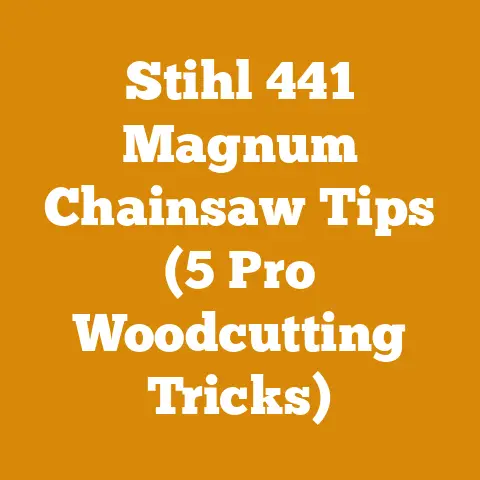How Do You Repair Damaged Bark on a Tree? (Pro Arborist Tips)
Have you ever walked through your yard and noticed a gaping wound on one of your beloved trees? It’s a sinking feeling, isn’t it? Damaged bark can be a serious threat to a tree’s health and longevity. As someone who’s spent years felling trees, processing timber, and preparing firewood, I’ve seen my fair share of bark injuries. I’ve also learned a lot about how to help trees recover. The good news is that with the right approach, you can often repair damaged bark and give your tree a fighting chance.
This guide isn’t about miracle cures; it’s about providing practical, pro-arborist tips that I’ve picked up over years in the field. I’ll cover everything from assessing the damage to applying appropriate treatments and preventive measures. Whether you’re dealing with a small scrape from a lawnmower or a more significant injury from wildlife, I’ll walk you through the steps to help your tree heal.
Assessing the Damage: A Crucial First Step
Before you even think about repairing the bark, you need to understand the extent of the damage. Not all bark injuries are created equal. A superficial scrape is vastly different from a deep wound that exposes the tree’s inner layers.
-
Superficial Wounds: These are usually minor scrapes that affect only the outer bark layers. They might be caused by minor impacts or rubbing. Typically, these heal on their own with little intervention.
-
Moderate Wounds: These wounds penetrate deeper, potentially reaching the cambium layer, which is the living tissue just beneath the bark responsible for growth. These wounds are more serious and require attention.
-
Severe Wounds: These are deep wounds that expose the wood (xylem) and often involve significant bark loss. They pose a significant threat to the tree’s health and can lead to decay and infection.
What to Look For:
- Depth of the Wound: How far into the tree does the damage go?
- Size of the Wound: How large is the damaged area? Measure the length and width of the wound.
- Evidence of Decay: Look for signs of rot, discoloration, or fungal growth.
- Overall Tree Health: Is the tree otherwise healthy? A healthy tree is more likely to recover.
- Location of the Wound: Wounds near the base of the tree are generally more serious than those higher up.
My Experience:
I once had a client who accidentally ran into a young maple tree with his truck. The wound looked terrible – a large section of bark was completely ripped off, exposing the wood beneath. After assessing the damage, I determined that the wound was severe, but the tree was otherwise healthy. This meant that with proper care, it had a good chance of recovery.
Understanding Tree Anatomy: The Key to Effective Repair
To properly repair damaged bark, you need a basic understanding of tree anatomy. Think of a tree like a complex plumbing system.
-
Outer Bark: This is the tree’s protective layer, shielding it from the elements and physical damage.
-
Inner Bark (Phloem): This layer transports sugars produced during photosynthesis from the leaves to the rest of the tree.
-
Cambium: This is the thin layer of actively dividing cells that creates new phloem and xylem (wood). It’s crucial for growth and healing.
-
Xylem (Wood): This is the main structural component of the tree and transports water and nutrients from the roots to the leaves.
Why is this important?
When bark is damaged, it disrupts the flow of nutrients and water within the tree. If the cambium is damaged, the tree’s ability to heal itself is compromised. Understanding these layers helps you determine the severity of the damage and the best course of action.
Tools and Materials: Getting Prepared
Before you start any repair work, gather the necessary tools and materials. Having the right equipment will make the job easier and more effective.
- Sharp Knife or Pruning Saw: For cleanly removing loose or damaged bark. I prefer a grafting knife for precision.
- Wire Brush: For gently cleaning the wound.
- Disinfectant: To sterilize tools and prevent the spread of disease. I use a 10% bleach solution or rubbing alcohol.
- Grafting Wax or Tree Wound Dressing: To protect the wound and promote healing. (More on this later)
- Gloves: To protect your hands.
- Eye Protection: Safety glasses are essential when working with tools.
- Optional: Burlap or Tree Wrap: To protect the repaired area from further damage.
A Note on Tools:
Sharp tools are safer and more effective. Dull tools require more force, increasing the risk of slipping and injury. Regularly sharpen your knives and saws.
Step-by-Step Guide to Repairing Damaged Bark
Now, let’s get to the actual repair process. Here’s a detailed step-by-step guide based on my experience.
Step 1: Cleaning the Wound
- Remove Loose Bark: Carefully use your knife or pruning saw to remove any loose, hanging, or severely damaged bark around the wound. Cut back to healthy, firmly attached bark. The goal is to create a clean, smooth edge.
- Clean the Exposed Area: Gently use the wire brush to remove any dirt, debris, or loose wood fibers from the exposed area. Be careful not to damage the cambium layer.
- Disinfect: Lightly spray the cleaned area with your disinfectant solution. This will help prevent fungal or bacterial infections.
Step 2: Shaping the Wound (Optional but Recommended)
- Create an Oval or Elliptical Shape: If the wound is irregularly shaped, consider using your knife or saw to shape it into an oval or elliptical shape. This promotes better callus formation (the tissue that grows over the wound to heal it).
- Smooth the Edges: Ensure that the edges of the wound are smooth and clean. Ragged edges can hinder healing.
Step 3: Applying Wound Dressing (Debateable)
- The Great Debate: The use of tree wound dressings is a controversial topic among arborists. Some argue that they seal in moisture and create a favorable environment for decay. Others believe that they protect the wound from insects and pathogens.
- My Stance: In most cases, I don’t recommend using wound dressings. Healthy trees are usually capable of healing on their own. However, in certain situations, such as very large wounds or wounds in areas with high disease pressure, a thin layer of grafting wax or a specialized tree wound dressing might be beneficial.
- If You Choose to Use a Dressing: Apply a thin, even layer of grafting wax or tree wound dressing to the exposed wood. Avoid applying it to the healthy bark surrounding the wound.
Step 4: Protecting the Wound (If Necessary)
- Burlap or Tree Wrap: For large wounds or wounds in areas prone to sunscald or animal damage, consider wrapping the repaired area with burlap or tree wrap. This will provide a physical barrier and protect the wound from further injury.
- Secure the Wrap: Use twine or tape to secure the wrap in place. Make sure it’s not too tight, as this can restrict growth.
Step 5: Monitoring and Maintenance
- Regular Inspection: Regularly inspect the repaired area for signs of healing or infection. Look for callus formation around the edges of the wound.
- Watering and Fertilizing: Ensure that the tree receives adequate water and nutrients. Healthy trees heal faster.
- Pest and Disease Control: Monitor the tree for signs of pests or diseases and take appropriate action if necessary.
A Case Study:
I once worked on a property where several young fruit trees had suffered bark damage from deer rubbing their antlers against the trunks. The wounds were significant, exposing large areas of wood. I followed the steps outlined above, carefully cleaning and shaping the wounds. I opted not to use wound dressing, but I did wrap the trunks with burlap to protect them from further damage. Over the next few years, the trees gradually healed, and the wounds were eventually covered with callus tissue.
Addressing Specific Types of Bark Damage
Not all bark damage is the same. Here’s how to address some specific types of injuries.
- Sunscald: This occurs when the bark is exposed to intense sunlight, causing it to crack and split. Protect the trunk with tree wrap, especially during the winter months.
- Animal Damage: Deer, rabbits, and rodents can all damage bark. Use tree guards or fencing to protect young trees.
- Lawnmower/String Trimmer Damage: Be careful when mowing or trimming around trees. Use tree guards to prevent accidental damage.
- Frost Cracks: These are vertical cracks that appear in the bark during periods of extreme cold. There’s not much you can do to repair frost cracks, but you can help prevent them by wrapping the trunk of young trees in the fall.
Preventing Bark Damage: The Best Defense
Prevention is always better than cure. Here are some tips to prevent bark damage in the first place.
- Protect Young Trees: Young trees are particularly vulnerable to bark damage. Use tree guards or fencing to protect them from animals and lawn equipment.
- Proper Pruning: Prune trees properly to promote healthy growth and prevent branches from rubbing against each other.
- Water and Fertilize: Healthy trees are more resistant to pests, diseases, and environmental stresses.
- Avoid Soil Compaction: Compacted soil can restrict root growth and weaken trees. Avoid driving or parking vehicles near trees.
- Be Careful with Equipment: Be mindful of trees when operating lawnmowers, string trimmers, and other equipment.
The Role of Wood Processing Knowledge
My experience in wood processing has given me a unique perspective on tree health. Understanding how trees grow and how wood decays has helped me become a better arborist. For example, knowing the moisture content of wood and how it affects decay rates has informed my decisions about wound treatment.
The Link Between Wood Decay and Bark Damage
When bark is damaged, it exposes the wood beneath to the elements. This can lead to wood decay, which can weaken the tree and make it more susceptible to pests and diseases. Understanding the different types of wood decay and how they spread is crucial for effective treatment.
- Brown Rot: This type of decay breaks down the cellulose in the wood, leaving a brown, crumbly residue.
- White Rot: This type of decay breaks down both the cellulose and lignin in the wood, leaving a bleached, spongy residue.
- Soft Rot: This type of decay occurs in very wet environments and is caused by fungi that can break down wood even in the absence of oxygen.
How Wood Processing Techniques Inform Bark Repair
My knowledge of wood processing techniques, such as drying and preservation, has also been valuable in bark repair. For example, I know that keeping the exposed wood as dry as possible is essential for preventing decay. This is why I often recommend wrapping wounds with breathable materials like burlap, which allows air to circulate while protecting the wound from the elements.
Advanced Techniques and Considerations
For more severe cases of bark damage, more advanced techniques may be necessary. These techniques should be performed by a qualified arborist.
- Bridge Grafting: This technique involves grafting healthy bark tissue from one part of the tree to another to bridge a gap in the bark.
- Inlay Grafting: This technique involves inserting a piece of bark from a healthy tree into a prepared space in the damaged area.
- Root Grafting: If the root system has been damaged, root grafting may be necessary to restore the tree’s ability to absorb water and nutrients.
When to Call a Professional:
If you’re dealing with a large or complex wound, or if you’re unsure about how to proceed, it’s always best to consult with a qualified arborist. They have the expertise and equipment to properly assess the damage and recommend the best course of action.
The Art and Science of Callus Formation
Callus formation is the natural process by which a tree heals a wound. It’s a fascinating process that involves the growth of new tissue around the edges of the wound, gradually closing it over.
-
Factors Affecting Callus Formation:
- Tree Health: Healthy trees form callus more quickly and effectively.
- Wound Size: Smaller wounds heal faster than larger wounds.
- Wound Shape: Oval or elliptical wounds heal faster than irregularly shaped wounds.
- Environmental Conditions: Adequate moisture and nutrients promote callus formation.
-
Encouraging Callus Formation:
- Proper Wound Cleaning: Removing loose bark and debris promotes healthy callus growth.
- Avoiding Wound Dressings (Generally): As mentioned earlier, wound dressings can sometimes hinder callus formation.
- Watering and Fertilizing: Providing adequate water and nutrients helps the tree heal itself.
The Importance of Tree Species
The type of tree you’re dealing with can also affect the repair process. Some tree species are more resilient and heal faster than others.
- Fast-Healing Species: Maple, oak, and willow are known for their ability to heal quickly.
- Slow-Healing Species: Beech, birch, and ash are slower to heal and may require more attention.
Knowing the species of your tree can help you set realistic expectations and tailor your repair efforts accordingly.
Firewood Preparation and Tree Health
You might be wondering what firewood preparation has to do with bark repair. Well, as someone who’s spent countless hours splitting and stacking firewood, I’ve learned that the health of a tree directly impacts the quality of its wood.
- Diseased Trees and Firewood: Trees with significant bark damage are often more susceptible to diseases and decay, which can affect the quality of the firewood. Decayed wood burns poorly and can produce excessive smoke.
- Sustainable Firewood Harvesting: When harvesting trees for firewood, it’s important to select trees that are already dead or dying. Avoid cutting down healthy trees, as this can harm the ecosystem.
- Proper Firewood Storage: Store firewood properly to prevent decay and insect infestations. Stack it off the ground in a well-ventilated area.
The Economic Impact of Tree Health
Beyond the aesthetic value, the health of your trees can have a significant economic impact. Healthy trees increase property values, provide shade and cooling, and reduce energy costs.
- Property Value: A well-maintained landscape with healthy trees can significantly increase the value of your property.
- Energy Savings: Trees provide shade, which can reduce cooling costs in the summer.
- Stormwater Management: Trees help absorb rainwater, reducing runoff and preventing erosion.
Investing in tree health is an investment in your property and your community.
Final Thoughts: A Long-Term Commitment
Repairing damaged bark is not a one-time fix. It’s a long-term commitment to the health and well-being of your trees. By following the steps outlined in this guide, you can give your trees the best possible chance of recovery.
Remember to be patient and persistent. Healing takes time, and it may take several years for a wound to completely close over. But with proper care and attention, you can help your trees thrive for many years to come.
Now that you have a better understanding of how to repair damaged bark, I encourage you to go out and inspect your trees. Look for any signs of damage and take action to address them. Your trees will thank you for it.
And remember, when in doubt, consult with a qualified arborist. They can provide expert advice and assistance to help you keep your trees healthy and beautiful.






